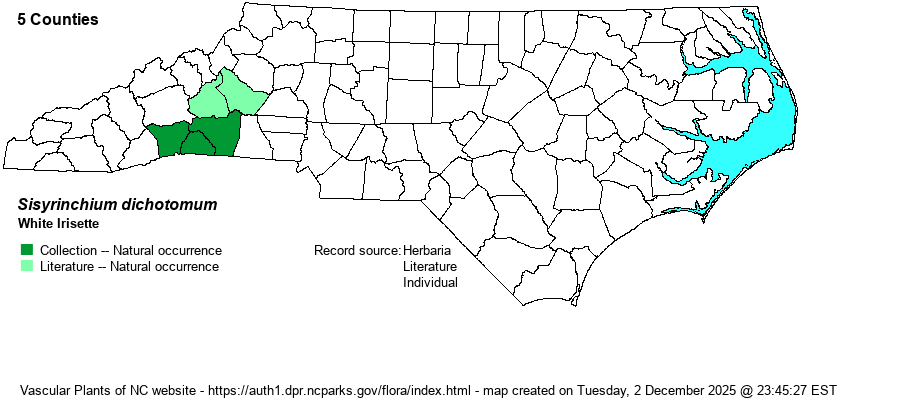| Author | Bicknell | |
| Distribution | This species is endemic to the southern Blue Ridge Escarpment region of southwestern NC and adjacent SC. Specimens are available for Henderson, Rutherford, and Polk counties, and observations farther northeast from McDowell and Burke counties.
The species is found only in a tiny area of southwestern NC and adjacent SC. | |
| Abundance | Within the Hickorynut Gorge region where Henderson, Polk, and Rutherford counties meet, the species is actually fairly common. Very rare and just a few individuals noted in Piedmont foothills in southern parts of McDowell and Burke counties. The NCNHP has several dozen records, and thus the State Rank assigned by them is S2 instead of S1, and the Global Rank is a matching G2. Because of its tiny range, it is a Federal and State Endangered species. | |
| Habitat | This is a blue-eyed-grass that requires or strongly favors high pH soils (over amphibolite rock, for example). It grows mostly in mesic situations, usually with partial sunlight. Favored sites are margins of Basic Mesic Forests or Basic Oak-Hickory Forests, such as a wooded edge, roadbank, or trail margin. It can grow in the shade of such forests but seems to do best with only partial shade. | |
| Phenology | Blooms from May into June, and fruits from June to August. | |
| Identification | This species is normally identified just by its flower color, plus the size and shape of them. It is a fairly tall Sisyrinchium, growing to 1-1.5 feet tall, usually with multiple ascending branches so as to look "bushy". The leaves are narrow and grass-like and nearly reach the top of the flowering stalk. The flowers are usually white, but can turn pale blue in age. They are about 1/3-inch across, but one characteristic of the species is the reflexed nature of the 6 tepals, such that the flower is not in a single plane but has swept-back tepals in full bloom. Though this is a Federally Endangered species, you can see the species by driving some public roads in the Chimney Rock and Bat Cave areas, and looking along wooded roadbanks and edges at the higher elevations (not in the valley along US 64). | |
| Taxonomic Comments | This species has no issues with taxonomy. For whatever reason, it was not mentioned in RAB (1968). As it seems unlikely that the species was discovered after publication (owing to so many records in some accessible places), it is assumed that the species was simply included within some other species in that publication.
| |
| Other Common Name(s) | Isothermal Irisette, Reflexed Blue-eyed-grass, Wishbone Blue-eyed-grass (owing to very long pedicels, causing the flowers to be 3-4" away from the stem). | |
| State Rank | S2 | |
| Global Rank | G2 | |
| State Status | E | |
| US Status | LE | |
| USACE-agcp | | |
| USACE-emp | | |

